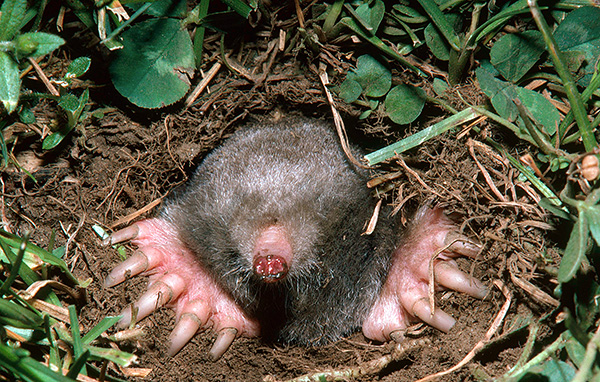 Moles are predatory mammals that spend almost their entire life underground, they can be met throughout Eurasia. The mole family includes 42 species.
Moles are predatory mammals that spend almost their entire life underground, they can be met throughout Eurasia. The mole family includes 42 species.
Of these, 4 species can be found in Russia:
Siberian - lives from Transbaikalia to the Irtysh River. In the North Caucasus you can meet the Small and Caucasian mole. But the most common species in the Russian Federation is European moles, it is also called ordinary.
The desman, who lead a semi-aquatic lifestyle, are considered relatives of moles. Neighborhood with them has both positive and negative sides.
The positive include:
- Destruction of harmful insects and the larvae laid by them.
- Loosening the soil.
- The destruction of rodents.

Despite the fact that moles do not eat vegetation, they often harm plants. The negative sides of such a neighborhood include:
- Moles eat earthworms that ennoble the soil. And as moles quickly destroy them, the soil becomes poor, and unsuitable for vegetation.
- Undermines made by moles are poorly reflected in buildings, they can violate the integrity of the foundation.
- These animals can be carriers of infectious diseases and parasites.
- After swarms of passages and burrows, they throw out the lower, not very fertile soil layers to the surface.
- When moving, they harm the root system of plants.
Definitely more harm from them than good, so gardeners and gardeners are trying to deal with them in all available ways.
Content
Preventative measures
Getting rid of moles is quite difficult, and in order not to have to spend precious time fighting them, it is necessary to prevent their occurrence. It may include:
- Landing in the garden of legumes and onions.
- Digging out trenches that need to be covered with broken brick, gravel, or gravel. You can sprinkle ordinary earth on top. But if the mole really wants to get to the site, such an obstacle will only delay him for a while.
- Fencing the entire site with durable materials such as linoleum, slate or roofing material. To do this, the selected material is dug into the ground by about 1 meter, the height of the fence should be at least half a meter.
Habitat
Moles are mainly found in loose and moist soil. These mammals do not like crushed stone and clay substrates. Moles have poorly developed hearing and vision, and a perfectly developed sense of smell and touch helps them navigate in space. The forelimbs are spade-shaped, the moles dig holes for them, and do it very quickly. They move at a speed of 6 km per hour.
A predatory mammal spends its whole life moving, in search of a suitable site with enough food. He lives with the family, ennobles his den under the ground, and makes it soft and comfortable. He digs many moves from which he makes his way in search of food. The animal eats earthworms, woodlice, earthen frogs, as well as insect larvae and other pests. Vegetation does not attract him, but when equipping passages, he inadvertently damages the root system of plants.Moles check their moves every hour, finding damage, repairing it somewhere, making an auxiliary tunnel from below.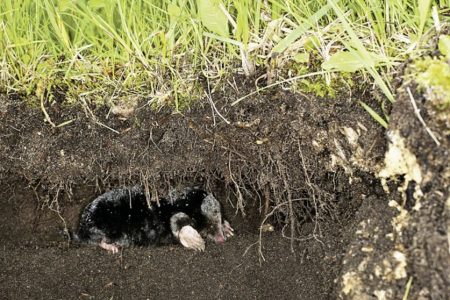
Moles are quite intelligent and cautious animals, they sense danger and try to avoid it. On the surface they can be seen very rarely. In order to get drunk, they dig vertical passages. With the advent of winter, shrew predators go deep underground, do not fall into hibernation. His enemies are foxes and raccoon dogs. Moles are protected by long, sharp claws and teeth.
Methods of struggle
Many methods have now been developed to get rid of unwanted neighbors. Each farmer can choose the right one for himself. There are both more humane and radical methods, and which ones can be read below.
Planting plants
- Marigolds have a pungent smell that moles do not like.
- Decorative flowering onions and imperial hazel grouse, animals simply can not tolerate, since the bulbs of these plants have a smell similar to a fox.
- If the whole plot is seeded with legumes, then the moles will disappear.
- The smell of caper milkweed will scare away the pest, but you should be careful with it, because its berries are poisonous.

Folk recipes
- In order to scare away the shrews, you can use a solution. To prepare it, mix 200 grams of castor oil and 4 tbsp. l washing, then measure 30 ml and diluted in 4 liters of water. The resulting solution is watered on previously moistened soil.
- Previously, tunnels were flooded with water to lure the animal to the surface. But when using this method, it is worth considering all its disadvantages. To begin with, it is worth mentioning that the site will be flooded, and this will negatively affect the plants that grow there. Also, the soaked soil will need to be compacted. And in the future, when it dries, there is a chance of the return of the harmful animal.
- A rotten herring in combination with a plastic turntable and cans will also help in the fight against moles. Herring and a homemade product are instilled in one of the moves, the sound and smell will come out rather unpleasant and this will scare away animals with excellent sense of smell.
Shovel
With the help of a shovel, they break the integrity of the dug mound and wait for the appearance of an undesirable neighbor, and he will certainly come to restore the dwelling. You need to wait about an hour, carefully observing the soil. At that moment, when the earth begins to move, they quickly pick it up with a shovel, throw it in a bucket and cover it so that the mole does not get out.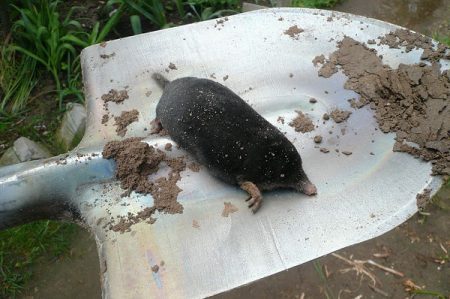
You can also violate the integrity of the tunnel, and insert a shovel in the path of the mole. With soil vibrations, the mole's waste is cut off with another shovel. The third shovel of the mole is taken out of the ground. But you need to do this very quickly.
Mole hunting
For catching you can use animals, cats or dogs. The dog should not be stupid, but in any case, the plantings can suffer, since the animal in the process of hunting can behave unpredictably. Moles will either become prey or will leave, having sensed the approach of a threat.
Cats can also catch or scare off shrews. The cat is taken to the site where the moles settled and kept ready. When soil is moving, it is brought closer and, having sensed the smell of prey, it will be happy to hunt.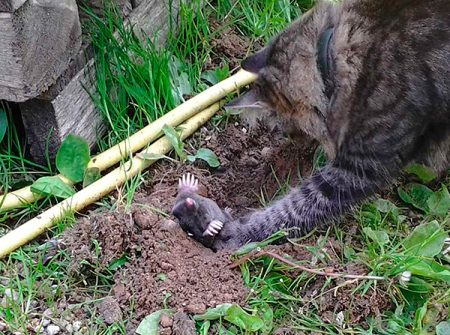
Underground fishing
You will need three-pointed hooks for fishing. First you need to damage the integrity of the hole, insert hooks attached to a strong fishing line into it. When the digger comes to repair the damage, he will certainly hook one of the hooks and it can easily be pulled out.
Mole repellent
Ultrasound
As you know, moles are susceptible to ultrasonic waves. This is probably why the market was replenished with special devices that have a depressing effect on these animals. The range of the device is approximately 20 meters, this should be taken into account during installation.Also, the devices have excellent protection against moisture, because the weather can be unpredictable. Ultrasonic repellers are recommended for installation in dense, well-compacted soil. A wave frequency of 400 Hz will force moles to leave their home.
Noise devices
They can be either purchased at the store or made independently without spending family funds. You can build a spinner from plastic bottles or cans, they are tied to the branches of trees, and in windy weather they make quite loud noises.
A very long time ago, when there was no such variety of means, reeds were put into burrows at about a meter deep. With gusts of wind, the noise of reeds resembles a howl, such a sound frightened moles and they left to look for a new home.
Firecrackers spread out around the entire perimeter of the site where moles live, during the explosion emit a very loud bang, from such a sound moles scatter. But nearby plants can be severely affected.
Smoke bombs
Acrid smoke will come from the drafts; the diggers who settled on the site will not like it. Moles can indeed leave, but animals from neighboring sites can come instead. It is also likely that these thoughtful carnivorous burrow passages from which toxic smoke emanates. And they will begin to rebuild their home. And it is worth considering that smoke bombs can harm crops that grow in the garden.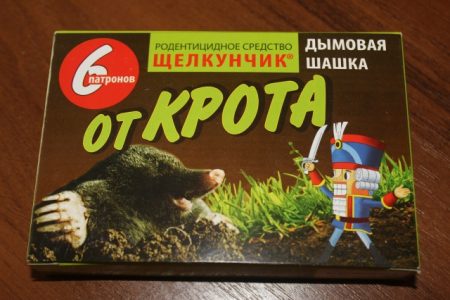
Insecticides
They should be used very carefully, because along with the moles the beetles with worms will die, and they ennoble the soil. Without them, the soil will become poor.
Poison
If scaring does not help, some gardeners resort to aggressive methods, such as poison. There are several varieties of it, one of them being “The Molehunter”. In order for it to work, you need to sprinkle the bait with poison, which earthworms can serve. They need to be dug up and treated with poison, and laid out in moves. It is better to do this in the evening, as moles are more active at night.
An extremely brutal method is considered to be electric killing, it is used when the animal comes to the surface. Someone makes self-arrows, and kills unfortunate animals with nails.
Trap
Solomon's trap
It is highly effective, while the animal will live, only in a different place. It is designed in the form of a cylinder, its diameter is about the same as the mole's moves, and the length of the trap is half a meter. A mole can get into it from both sides, but it cannot get out. It is installed in a tunnel, and they wait until the prey is caught, then the animal is carried outside the gardens and released.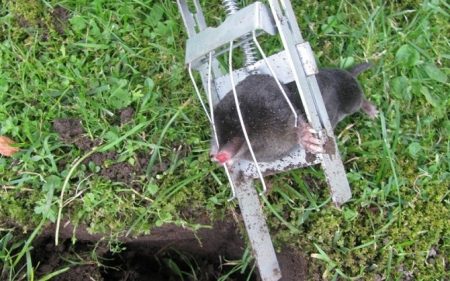
Mole catcher
Such a device is installed directly in the hole. An unsuspecting mole crawls on its own moves, touches a spring or valve and comes across.
You can also make a trap yourself, for its manufacture you will need a 50 cm water pipe, in which you need to cut the door on the side. Go in, he will come in, but he will not be able to go out.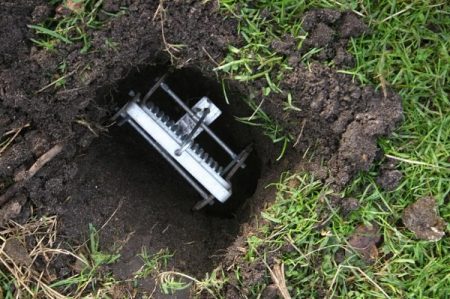
Traps
They can be purchased at a specialty store. An excellent option is the "Claw", its device resembles scissors, and there is a check between the blades. When the animal accidentally touches it, it is between the blades.
Chemicals
There are a lot of such products; they all have a pungent odor. According to gardeners, “Argus from moles” is an excellent remedy, the main component of this drug is aluminum phosphide. In contact with water, the substance emits toxic gas. In use, the gel is quite simple, you just need to squeeze it into the hole with a syringe. It is enough to take 5-10 grams.
Some gardeners use calcium carbide with the addition of phosphide and calcium arsenide. When water is added, substances emit various gases. It will scare off diggers and kerosene with turpentine or gasoline, other solvents can also be used. But it should be noted that after such aggressive means, the quality of the soil deteriorates.
You can also use the Dr. Klaus. This is a concentrated substance with an ejector, against various types of rodents. The nominal volume of the product is one liter. Use it in early spring, screw the hose to the ejector, set it up, turn on the water and water it.
Specialists help
If not one of the above methods helps or if there is no time to engage in trapping or destroying moles, qualified specialists will come to the rescue, who can easily cope with the task and also give a guarantee. If the pests return within the time specified in the official contract, they will come again, but for free. Of course, the challenge of specialists will require considerable financial costs, the cost of services depends on the region.
They use methods such as:
- Fumigation is a highly effective method, the essence of the procedure is to treat the area with a poisonous cloud.
- Set traps.
- Gassing is the treatment of moves dug by moles with chemicals.
Conclusion
In some ways, moles are useful, but, unfortunately, there is much more harm from them. Therefore, most gardeners, noting the presence of new residents on their land, begin to fight them. There are many ways to destroy and scare away these animals, and everyone can choose the right one. You can achieve an excellent result by combining several methods.


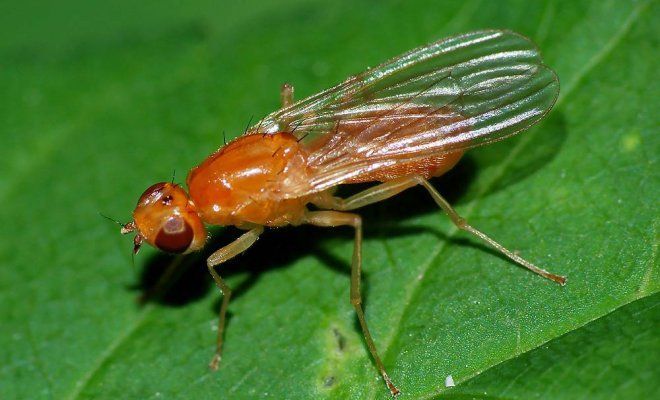
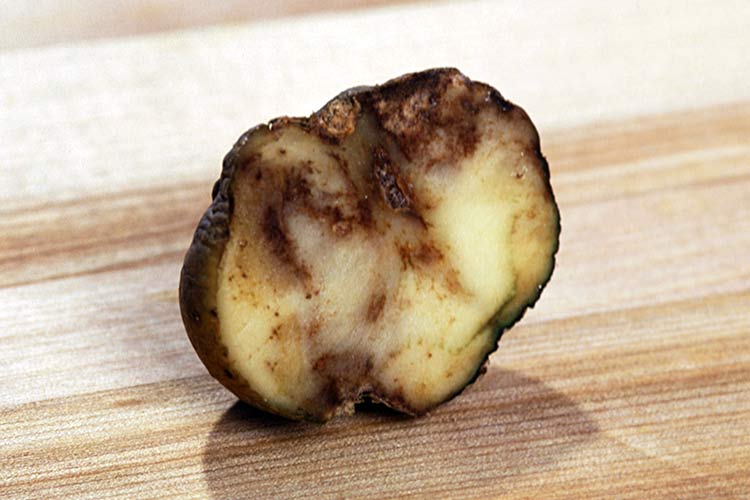
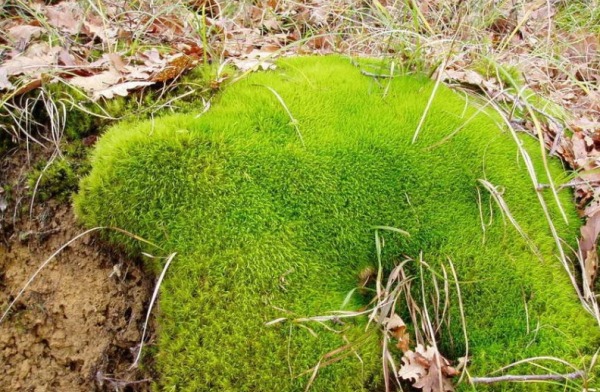 Where does moss come from in the garden and is it necessary to get rid of it?
Where does moss come from in the garden and is it necessary to get rid of it?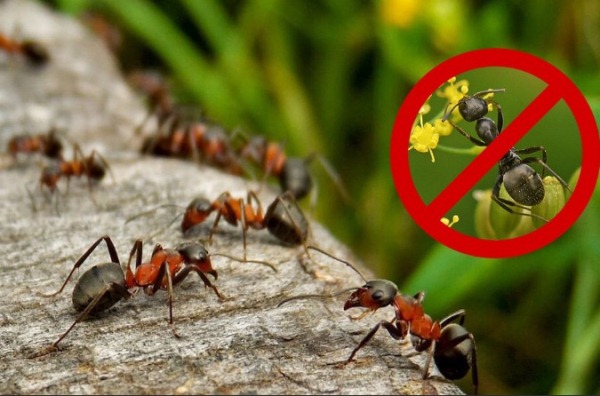 The most effective ways to deal with ants in the area
The most effective ways to deal with ants in the area Cockchafer and Bear: An Easy Way to Save Plant Roots
Cockchafer and Bear: An Easy Way to Save Plant Roots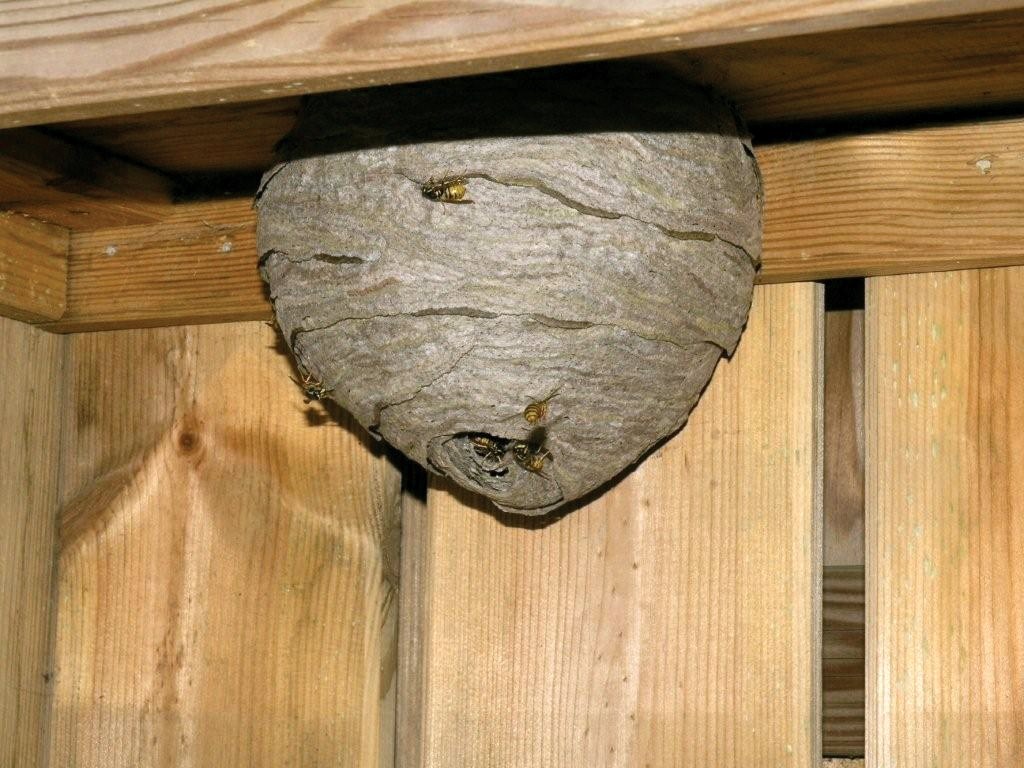 Get rid of the aspen nest quickly and safely.
Get rid of the aspen nest quickly and safely.
Alexander
Only fishing hooks.